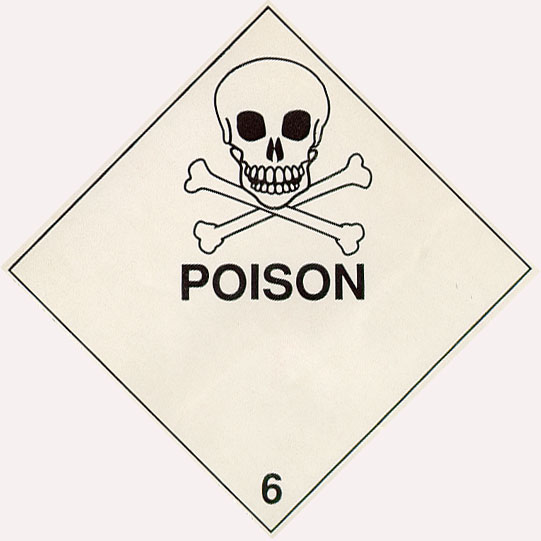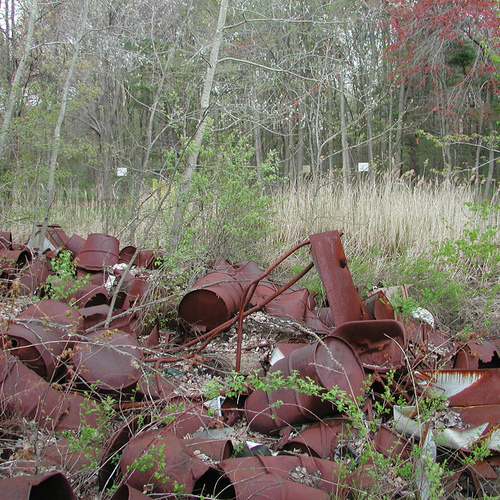
Image Credit: Public domain
Are green builders more fearful than most Americans? It would certainly appear so, since so many of them show signs of an almost paranoid obsession with toxins.
If you Google “green building + toxic,” you’ll be flooded with 354,000 results. Distributors of green building materials routinely advertise that their products are “non-toxic.” The implication, of course, is that conventional building materials from your local lumberyard are toxic. One supplier even advertises “non-toxic” plaster. Who knew that conventional plaster could cause illness or death?
In an article for Builders Exchange magazine, Paul Novack, the director of sustainability at a Brooklyn, N.Y., building material supplier, wrote, “The fastest growing market in green building is the owner who understands the health dangers of using conventional construction products. A designer or contractor who can become an expert in non-toxic products will soon become a sought-after green contractor in his market.”
Picking up the same theme, a blogger reporting on one of Novack’s seminars wrote, “Toxics, toxics, toxics. They are all around us, especially in our homes and offices, according to speakers Cameron Lory and Paul Novak at GreenHome NYC’s monthly forum, Non-toxic Building Materials.”
Defining “toxic”
“Toxic” has a simple definition; it means “poisonous.” Are U.S. lumberyards actually filled with poisonous building materials? Are federal regulatory agencies totally asleep? Opinions differ, but many green building advocates are eager to answer “Yes!” to both questions.
From my perspective, however, any builder touting the virtues of “non-toxic” building materials needs to step back for a moment. For one thing, most generalizations about the toxicity of conventional building materials are wildly unscientific. Second, it’s important to remember that builders shouldn’t be providing medical advice.
So what should do you do if a potential client says, “My son has asthma. Can you build…
Weekly Newsletter
Get building science and energy efficiency advice, plus special offers, in your inbox.

This article is only available to GBA Prime Members
Sign up for a free trial and get instant access to this article as well as GBA’s complete library of premium articles and construction details.
Start Free TrialAlready a member? Log in














9 Comments
Worthy area of investigation
Excellent piece about toxics and one that will probably stir up a hornet's nest for you. When I worked at a builder's magazine, I regularly (and unsuccessfully) proposed that we do a story looking into the phenomenon of multiple chemical sensitivities, where people need to live in special houses with unpainted plaster walls, no carpeting, etc. I believe that there's a substantial body of evidence suggesting that multiple chemical sensitivity DOES exist but that it's a psychosomatic problem, not a physiological one. [Editor's note: After Jon Vara posted this comment, GBA published an article on the topic he suggested: Helping People With Multiple Chemical Sensitivity.]
As I understand it, the key distinction is that just because a problem is psychosomatic doesn't mean it's imaginary — maybe there's no direct physical cause, but it can make you very sick. In other words, a person with MCS probably isn't imagining their illness or making it up in the sense that a kid pretends to be sick to get out of going to school — the MCS sufferer may actually be running a fever, vomiting, etc. It's just that it's not directly caused by the outgassing from the plywood sheathing, but rather by the sufferer's fear and concern about the outgassing from the plywood. You can probably even cure it by getting rid of the plywood, but it was never really the plywood's fault.
That's all loose talk on my part. But I think it would be useful and interesting to get the straight story from medical/public health experts. Surely there are some actual studies about this, as opposed to mushy anecdotal stuff?
JV
give people credit
"If any builder has evidence that a specific building material is actually toxic, the solution is regulatory, not architectural. In other words, it’s time to write a letter to your representative, print up some leaflets, or lobby the government for tighter regulations."
So how's that going? The government is woefully behind in regulating things of all sorts, from cars to appliances to chemicals. There have been some hopeful signs lately, but even if things go extremely well in the coming years on that front, it'll take a long time to do the research needed to resolve the many questions out there.
Even successful regulations tend to converge on a lowest-common denominator rather than a leadership standard. I don't want a home that is minimally safe, I want a home that is completely safe. To do that I do my own research and my own work. If I needed to hire a builder, I would look for someone who distinguished themselves in understanding these issues. As your Google search demonstrates, a lot of people are doing just that. You prefer leaflets... websites are the leaflets of today.
I don't disagree with your point that there is a lot of over-reactionary fear-mongering that misunderstands a lot of issues, but give people credit for paying attention and being concerned.
Putting people in silos based on expertise is part of how we got into this problem. Health should be part of the builder's vocabulary, just as it should be part of the vocabulary for farmers, teachers... and on.
How long will the research take?
Tristan,
You point out, "It'll take a long time to do the research needed to resolve the many questions out there." I agree.
The necessary research is best done by public health professionals and medical researchers. I don't pretend to be an expert in these subjects. I value the expertise of those who have devoted their lives to these topics.
Guessing won't do. I'm a die-hard believer in the scientific method, and the necessary research to settle these matters should not, as a general rule, be performed by builders.
Of course our government is less than perfect! It's going to be a long slog from here to a perfect society, and I'm all in favor of political action. If you and I agree that our government should devote more dollars to the type of research we're talking about, that's great.
If political action is required, choose from the time-honored list of possible activities: voting, lobbying, cajoling, letter-writing, picketing, nonviolent civil disobedience, or (the favorite of the American founding fathers) violent revolution. (I'm going to pass on the last option.) But don't give up on the scientific method.
scientific method
I think it's unfortunate that most citizens think of science as something that only people wearing lab coats can do.
Yes, the scientific method is horribly misunderstood in large swaths of our culture. Look at the "evolution is just a theory" crowd for evidence of that.
But remember that the scientific method has its roots in phenomenology -- that is, the study of phenomena from a first-person perspective. If I eat a root and I suddenly feel sick, I'm going to think twice about eating it again. If a friend also gets sick after eating the same root -- lo and behold, we have an experimental group. If another group of people I know didn't eat the root, and didn't get sick, we have a rough-and-ready control group!
Science always starts with an idea or an observation.
So if I use a certain building material, and I get sick, or raise a family in a certain home made of that material, and my kids get asthma, I'm going to look around for links. The government is never going to be there to protect me from every known harm, nor would I want it to be. If they don't think the material is poisonous, I'll consider that, but I'll also consider my own experience and act accordingly. Maybe I'll stop using it pending further research (the "precautionary approach.")
So again -- yes to science, yes to research, yes to responsible use of terminology like "non-toxic." But also -- yes to citizen awareness, observation, personal responsibility, and evolution of market forces to meet our needs (such as builders who are aware of health issues).
Are there any builders reading this who have confronted these issues in their work?
Where we can agree
Tristan,
Here's where we agree: yes to science, yes to research, yes to responsible use of terminology like "non-toxic."
A warning to builders, however: it's important to avoid making marketing claims that can't be backed up with proof. I'm sorry, but "my friends live in a house with carpeting, and their kid has asthma" just doesn't cut it. That's the beauty of the scientific method: it weeds out the snake-oil salesmen from people making responsible claims based on data.
Tristan asked "Are there any
Tristan asked "Are there any builders reading this who have confronted these issues in their work?"
Yes. Regularly. Customers are constantly looking for advice, ideas, reccomendations on which products to use, or avoid.
I agree we need better regulation, but each of us also has to take responsibility for the products and methods we use, reccomend, sell.
The healthy building movement is becoming more and more mainstream because it makes sense. Building professionals of every stripe need to learn as much as they can towards designing and building healthy and responsible buildings.
Multiple Chemical Sensitivity (MCS)
The toxicity of modern building materials is a health issue for everyone, not just people with Environmental Illness and/or Multiple Chemical Sensitivity (MCS). I agree that the regulation needs to be done at the point of origin of the products, and that the government should be overseeing the regulatory process.
To commenter Jon Vara: saying MCS is psychosomatic is 15-20 years behind the times. In fact, the DSM-IV, the manual of the psychiatric profession, does not recognize MCS as a psychological disorder. Good article here: http://www.getipm.com/personal/mcs-campbell.htm . Further, as a point of clarification, MCS is not an allergy either.
Also, as another point of clarification, “toxin” is a poison produced by a living organism. “Toxic” is poison by chemical means. People tend to mix up the terms. People with MCS have adverse reactions when exposed to certain toxic chemicals not necessarily toxins (an exception may be with something like toxic mold). If people with MCS have allergies to toxins or toxics, it is a separate health issue.
It may interest you to know that Multiple Chemical Sensitivity is recognized as a disability by the Social Security Administration, HUD and the Americans with Disabilities Act, among others. For a list of published peer-reviewed articles documenting the “realness” of MCS, go to http://www.chemicalsensitivityfoundation.org and http://www.mcs-america.org/index_files/MCSScientificStudies.htm . This chemical sensitivity condition is not rare and the numbers of people who have it are growing.
I agree that the ultimate responsibility lies with the government to regulate toxic chemicals in building materials at the point of origin. But changing the laws governing corporations is a slow process, even when in the best interest of public health. Changes to public health policy often start at the local level, as has been the case with smoking, and is often sparked by concerned mothers, the scientists who are doing the research, and those of us who are ill from the offending products. My hope is that green architects and builders will also do their homework and chose to use nontoxic materials. Unfortunately, among green building trends, which are most often linked to global warming issues, indoor air quality tends to be ignored.
Clean air is everybody’s business, and seeing this issue as a fundamental health issue is the only way we will ever get consensus on taking the necessary action to protect everyone.
Toxic Building Materials
As a person who uses building materials at work every day, I am definitely very interested in how toxic they are, both for the finished product that ends up in a customers home and for the sake of my own health working with the material. And where it might be nice to think that the government should be protecting us from any chemicals that might possibly harm us and our children, we really need to face the fact that this is not the case in our world today. There are so many chemically laden products, not just building products, that we need to navigate our way through to avoid our houses being filled with chemical soup! As professional users of building materials, we are naturally the obvious people to go to for information about what building materials are appropriate for our customers specific requirements.
Many people, not just those with mcs, are interested in doing everything they can to have clean air in their homes ... And surely if you look at the list of chemicals used in making many of the more toxic building materials, carpets, and also mass produced furniture you have to agree that those chemicals go somewhere ... I know builders who refuse to use some building materials that customers wish to use to cut corners, because the builders themselves don't want to subject their workers to the toxic materials ...
I am a tiny bit suspicious that the author has written this article just to wind people up ... There are many different health problems that are considered to be caused by chemical toxins and I would really recommend erring on the side of caution. We certainly can't sit around waiting for the government to protect us!
Response to Jon Vara
Jon,
You wrote, "I believe that there's a substantial body of evidence suggesting that multiple chemical sensitivity DOES exist but that it's a psychosomatic problem, not a physiological one. ... I think it would be useful and interesting to get the straight story from medical/public health experts."
Here's the article you requested: Helping People With Multiple Chemical Sensitivity.
Log in or become a member to post a comment.
Sign up Log in